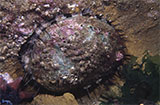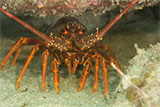Leopard Seal Reef
![]() Reef Dive |
Reef Dive | ![]() Boat access
Boat access
![]()
![]()
![]()
![]()
Depth: 6 m (20 ft) to 20 m (66 ft)
Level: Open Water and beyond.
The Leopard Seal Reef dive site on the southern side of Lady Julia Percy Island gets its name from the visible triangular reef coming out from the cliff. There is an above water cave immediately to the north. Around the reef edge there are some really interesting giant underwater rock pools (10–14 metres), complete with oversize "pebbles" to suit.
Lady Julia Percy Island
Lady Julia Percy Island (also known by its Aboriginal name Deen Maar) has to be one of the most incredible diving destinations in Victoria. Ringed by cliffs, with a flat treeless top, the 1.33 square kilometre (329 acres) island is owned by the seals.The island lies 12 kilometres south-south-west of Yambuk, and 22 kilometres south-west of Port Fairy. Lady Julia Percy Island is about 2 kilometres in length by 1 kilometre wide, comprising a plateau in height from 32–46 metres above sea level, surrounded by cliffs, rock platforms and reefs. Access to Lady Julia Percy Island itself is restricted, and landing is by permit only.
The diversity of marine life, crystal clear water (frequently), rock walls, caves, sand flats, and boulder fields all combine to make this place just stunning. Dolphin, southern elephant seals, Australian sea lions and even killer whales have been observed here. The island can have a particularly ominous feel to it, particularly on an overcast day, but on the right day it is just paradise above and below the water.
Lady Julia Percy Island is famous as the home to the largest colony of Australian Fur Seals in the Southern Hemisphere, and infamous for large Great White Sharks. The sheer number of seals can be a little overwhelming (sight sound and smell), but they are just a part of the wildlife attraction. Mention Lady Julia Percy Island and everyone immediately thinks of sharks, but as any honest abalone diver will tell you, sightings are rare, and they don't eat much anyway.
This island is home to breeding little penguins (2000 pairs), common diving-petrels (1000 pairs), fairy prions (1000 pairs), and short-tailed shearwaters (15,000 pairs). There are also peregrine falcon and sooty oyster catchers. A number of small but unusual plant species survive in the caves in the cliff walls.
Diving Lady Julia Percy Island
Diving at Lady Julia Percy Island is often restricted to the northern or leeward side. The broken bottom and varying depths make this a very interesting dive area.
With the exception of North East Reef, the best underwater scenery is generally found close in to the cliffs. The best terrain generally lies within a 40 metre radius of the island's cliffs, where depths will range from 1 to 20 metres. Whilst some sections are more interesting than others, none will disappoint!
On very good, calm days when you can dive in front, on the ocean side, of the island it becomes simply amazing. There is a very big drop-off across the front of the island, 50 to 70 metres offshore. This drop-off descends from 10 metres to 40 metres deep.
There is at least one very large cathedral-like cave near the base of the drop-off at the south-west end of the island. In the waters on the western side of Lady Julia Percy Island in Prop Bay lies pieces of the RAAF Avro Anson AW-878 aircraft wreck which crashed there on Tuesday, 15 February 1944.
Lady Julia Percy Island is a wonderful dive site but you have to take into account the possibility of shark attacks. Diving here should be avoided during the summer seal pupping season as that can marginally raise the shark attack risk. It's recommended to use a Shark Shield when diving near the island.
Access is by boat from the Port Fairy, Griffiths Street Boat Ramp. Best dived in good conditions with a low swell with light north or northerly winds. You're also a long way from port if the conditions turn and the sea cuts up rough. See WillyWeather (Lady Julia Percy Island) as a guide for the tide times and the height of the tide.
Dive sites at Lady Julia Percy Island include:
- Avro Anson AW-878 — aircraft wreck in Prop Bay.
- Haystack— reef in Prop Bay.
- Prop Bay Bommie
- Blowhole, Lady Julia Percy Island — Thunder Point at the south-east end of the island.
- Bobs Rock — 4.2 kilometres from the south-east point of island.
- Leopard Seal Reef — southern side of island.
- Channel Bay — southern side of island.
- First Cave — Cape Frederick at the north-eastern tip of island.
- North East Reef — 250 metres from the north-east tip of island.
- Landing Bay — northern, leeward, side of island.
- Lady Julia Percy Island — northern, leeward, side of island.
Lady Julia Percy Island History
Lady Julia Percy Island is Australia's only submarine volcano formed some seven million years ago. When lava erupts underwater a typical type of lava called pillow lava occurs. These are tube like structures where the interaction with water forms a crust on the outside and molten lava continues to flow inside. It is Australia's only off-shore volcano and the only large basalt island off the coast of western Victoria.
Deen Maar was well known to the Gunditjmara people. It is believed that the spirits of the dead were conveyed across the sea to the island from a cave called Tarnwirring ("the flowing of the wind") at the top of a rocky sea cliff. The island was also known as Tirngoona, meaning "where the sun go away longa night".
The island was given the name "Lady Julia's Island" in 1800 by Lt James Grant after either the wife or daughter of Hugh Percy, 2nd Duke of Northumberland. In 1802 Matthew Flinders expanded the name to Lady Julia Percy's Island as he sailed past on his ship the Investigator. Also in 1802, Nicolas Baudin sailed past the island in his ship the Geographe, and recorded the island as "Ile aux Alouettes", a name that has not persisted.
During the early 19th century, sealing took place with sealing gangs living on the island often for months at a time. There are two graves on the island — one of a sealer buried in 1822, and one of a man named Hardman buried in 1828 by Captain Wishart of the Fairy. Guano was mined on the island for fertiliser until 1861, being transported to Port Fairy in barges.
In January 1936 a scientific expedition from Melbourne University's McCoy Society visited the island for six weeks and carried out a comprehensive ecological survey.
The local Gunditjmara people have a spiritual, traditional and contemporary connection to Deen Maar (Lady Julia Percy Island). This land is the traditional home of the Peek Whurrong speakers of the Dhauwurdwurung (Gunditj Mara) Nation and is of special cultural significance to local Aboriginal people. Bunjil, the Creator, left this world from Deen Maar, and the adjoining mainland and wetlands are also of great spiritual significance.
Divers have the opportunity to catch Abalone at this dive site. Remember your catch bag, legal abalone tool, current Victorian Recreational Fishing Licence, and abalone measure. Please abide by all current fishing regulations if you intend to catch abalone.
See article-catching-abalone for practical abalone hunting advice from The Scuba Doctor, plus melbourne-abalone-dives for a list of other Abalone dive sites near Melbourne.
Divers have the opportunity to catch Southern Rock Lobster (aka Crayfish) at this dive site. Remember your catch bag, current Victorian Recreational Fishing Licence, rock lobster measure, and cray tags. Once you get back to the dive boat, or shore, make sure you clip the tail and tag your Crayfish as per Fisheries requirements. Please abide by all current fishing regulations if you intend to catch crays. See article-catching-crayfish for practical cray hunting advice from The Scuba Doctor, plus melbourne-cray-dives for a list of other crayfish dive sites near Melbourne. For tips on cooking your Crays, please see article-cooking-crayfish.
Traditional Owners — This dive site is in the traditional Country of the Eastern Maar people of south-western Victoria between the Shaw and Eumerella Rivers and from Yambuk in the south to beyond Lake Linlithgow in the north. This truly ancient Country extends as far north as Ararat and encompasses the coastal townships of Port Fairy in the west, Warrnambool, Peterborough, Port Campbell, Apollo Bay, Lorne, and Airies Inlet in the east, including the Great Ocean Road area. It also stretches 100 metres out to sea from low tide and therefore includes the iconic Twelve Apostles. "Eastern Maar" is a name adopted by the people who identify as Maar, Eastern Gunditjmara, Tjap Wurrung, Peek Whurrong, Kirrae Whurrung, Kuurn Kopan Noot and/or Yarro waetch (Tooram Tribe) amongst others. We wish to acknowledge the Eastern Maar as Traditional Owners. We pay respect to their Ancestors and their Elders, past, present and emerging.
Leopard Seal Reef Location Map
Latitude: 38° 25.399′ S (38.423311° S / 38° 25′ 23.92″ S)
Longitude: 142° 0.087′ E (142.001446° E / 142° 0′ 5.21″ E)
Datum: WGS84 |
Google Map
Added: 2021-07-13 12:24:57 GMT, Last updated: 2021-07-13 12:31:07 GMT
Source: Peter Ronald GPS
Nearest Neighbour: Blowhole, Lady Julia Percy Island, 384 m, bearing 222°, SW
Lady Julia Percy Island, Discovery Coast.
Depth: 6 to 20 m.
[ Top ]
DISCLAIMER: No claim is made by The Scuba Doctor as to the accuracy of the dive site coordinates listed here. Should anyone decide to use these GPS marks to locate and dive on a site, they do so entirely at their own risk. Always verify against other sources.
The marks come from numerous sources including commercial operators, independent dive clubs, reference works, and active divers. Some are known to be accurate, while others may not be. Some GPS marks may even have come from maps using the AGD66 datum, and thus may need be converted to the WGS84 datum. To distinguish between the possible accuracy of the dive site marks, we've tried to give each mark a source of GPS, Google Earth, or unknown.






